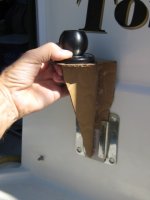Professional Hobbyist
New member
I'm wanting a Walker Bay 8 RID or a Portland Pudgy dinghy for use with my 22 Cruiser. They are too big and heavy for the cabin top and I don't want to tow on a line at reduced speeds so I have another idea. I want to build a tow hitch similar to a car's trailer hitch and tow the dinghy attached directly to the stern of my 22.
This tow hitch would be made of stainless steel tubing and attach to the transom. It would stick out slightly beyond the outboard(s) and the dingy would attach to it "trailer style". The mount would straddle the outboard(s) and would probably have three to four mounting brackets, points of contact with the 22. It would be removable for towing the 22 behind my truck.
The bow of the dinghy would be out of the water and it would ride on its transom in the power boat's wake. I think this would allow it to skim/plane along behind the towing boat at what ever speed it is traveling at. The idea is to keep the weight of the dinghy off the C-Dory, keep the dinghy in/on the water eliminating the need to lift it, and to be able to cruise at top speed when I want or need to. I could also use the dinghy as a trailer and carry gear in it like extra fuel. If I've explained this well enough for you to understand the concept do you see any problems with this idea? Do you think it would work?
This tow hitch would be made of stainless steel tubing and attach to the transom. It would stick out slightly beyond the outboard(s) and the dingy would attach to it "trailer style". The mount would straddle the outboard(s) and would probably have three to four mounting brackets, points of contact with the 22. It would be removable for towing the 22 behind my truck.
The bow of the dinghy would be out of the water and it would ride on its transom in the power boat's wake. I think this would allow it to skim/plane along behind the towing boat at what ever speed it is traveling at. The idea is to keep the weight of the dinghy off the C-Dory, keep the dinghy in/on the water eliminating the need to lift it, and to be able to cruise at top speed when I want or need to. I could also use the dinghy as a trailer and carry gear in it like extra fuel. If I've explained this well enough for you to understand the concept do you see any problems with this idea? Do you think it would work?

